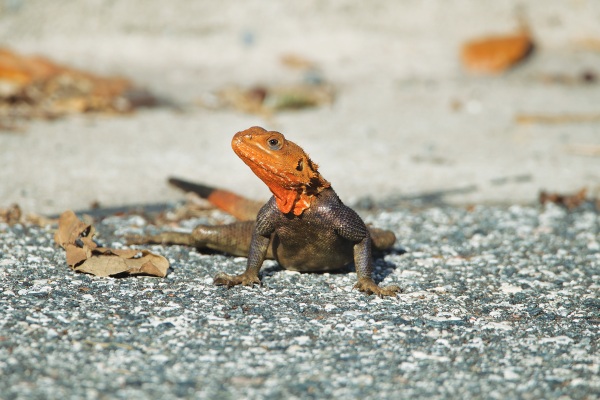News Update
Non-Native Lizards Pose Significant Threat to Florida Ecosystems
Daniel J. Torres
Author
Barring an ice age, Brevard County, and much of Central Florida, will eventually come to resemble the Florida Keys: Burmese pythons, Argentine white tegus, lionfish and Cuban treefrogs are just a few of the invasive species damaging the indigenous landscape of Florida. Add the Peter’s rock agama (Agama picticauda), a large lizard native to Sub-Saharan Africa, to an ever-growing list of non-native species released into Florida in the 1970s via the pet trade.
The Peter’s rock agama can grow up to 18 inches in length, with males boasting a dark gray or black body and bright orange head. While females are not as colorful, they can grow to roughly the same size as their male counterparts.
“This particular species doesn't take over a niche that is being filled by a native species, think green anoles and the invasive brown anole. Although what we have found in South Florida with iguanas, for example, is that they are voracious herbivores and are decimating native and exotic vegetation at a significant rate,” said Christopher Koeppel, an environmental specialist with Brevard County Natural Resources that has been tracking exotic and non-native species within the county. “If an exotic was an omnivore or carnivore. then the carnage is carried over to anything native, and smaller than the predator.” This is precisely what is happening with Cuban Tree frogs, which are annihilating entire amphibian ecosystems in Florida. Very few predators have adapted to eat these frogs due to their disagreeable secretions.

Brevard County is not the only part of Florida that is concerned by the Peter’s rock agama’s growing presence. Sightings have been noted all along the Treasure Coast, and as far north as Jacksonville and other parts of Duval County, with sightings growing increasingly frequent in the past year.
“I noticed a correlation between landscaping materials and plants from South Florida and where the rock agama was showing up,” said Koeppel, also noting reported sightings throughout Central Florida by various landscaping outlets in 2021. Each outlet reporting a sighting receives its materials from South Florida.
"In their native range of East Africa, they are mostly insectivorous but have also been observed eating small mammals, birds, small reptiles, and vegetation such as flowers, grasses, and fruit," states the University of Florida Institute of Food and Agricultural Sciences. This and other omnivoric species have the high potential to impact native species, as most native herpetofauna are too small, and easily preyed upon by exotic, non-native species.
One major concern is the threat this invasive lizard poses to the Miami Blue Butterfly — a small butterfly once common throughout coastal Florida, which is now considered a critically endangered species. In fact, this species of butterfly was believed to be extinct. After Hurricane Andrew swept through the state in 1992, there were no confirmed sightings of the Miami Blue for seven years. A very small population of wild Miami Blue Butterfly still exists in the wild, but researchers are concerned the Peter’s rock agama could pose a significant threat.
In short, Florida is under an onslaught of exotic predators. Researchers now estimate that non-native lizards outnumber natives three to one, with Florida already home to more than 50 non-native species.
“Imagine what would happen if a lounge of lizards came upon an endangered Least Tern colony on a supermarket rooftop” postulates Koeppel. “It would be a complete loss of a bird colony, including offspring, and possibly adults.” A complete non-native takeover would drive away reproductive adults in the least, resulting in colony failure at that site, leading to relocation, which is typically suboptimal. Reproductive pressures like this generally lead to colony collapse, ultimately impacting many more animals than the few whose nests were decimated.
While researchers are aware of Peter’s rock agama in various locations throughout the state, they urge citizen scientists to report sightings using the EDDMapS online mapping tool, found on eddmaps.org.

